We wanted to provide you with the best resource on dog safety for 2020!
This is a LONG post divided into 8 categories with different dog safety tips such as travel, hot weather, camping, hiking and more. You can use the links below to jump ahead to each section.
We hope you’ll share this post if it will help someone you know, and please leave your own dog safety tips in the comments!
*To get this post emailed to you as a pdf, click here. Read it later at your convenience.
Dog Safety Tips Table of Contents:
1: Dog Travel Safety
Safety tips for traveling in the car or truck with your dog.
2: Cold Weather Safety for Dogs
How to safely walk and hike with your dog in the winter.
3: Hot Weather Safety for Dogs
Keep your dog safe in the summer months and prevent him from overheating.
4: Camping and Hiking Safety for Dogs
Safety tips for dogs on all your hiking and camping adventures.
5: Common Household Poisons for Dogs
Common items both inside and outside that are poisonous to dogs such as certain foods, household items and yard hazards.
6: First Aid for Dogs
In an emergency it could take 20 minutes or more to get to the vet. This is why it’s important to know at least the basics of pet CPR and first aid.
7: Safety When Introducing 2 Dogs
Most dogs are able to greet other dogs without issues, but sometimes people can unintentionally set their good dogs up for failure. Learn what kinds of mistakes to avoid.
8: Dog Safety Products – Top Picks
Our top picks for dog safety products such as a dog first aid kit, a dog seat belt and a dog GPS collar.
Dog Travel Safety
Most of us love to travel with our dogs whenever possible, so let’s start with some basic travel safety tips:
- Make sure your dog’s ID tag and microchip are up to date!
- Use a well-fitted collar or harness to prevent slipping out
- Keep photos of your dog in your phone to show in case your dog gets lost (I know you have hundreds!)
- Bring a water bowl for your dog + water
- Bring a coat or blanket for your dog in cold weather, in case of car trouble
- Pack your dog’s medications and a dog first aid kit
Dog safety belt for the car
When traveling with your dog, we highly recommend using a dog safety belt. This is not only to keep your dog secure but to keep him from distracting the driver.
Don’t be that person with a dog in her lap while driving or the person texting with one hand, blocking the dog with the other and still somehow driving!
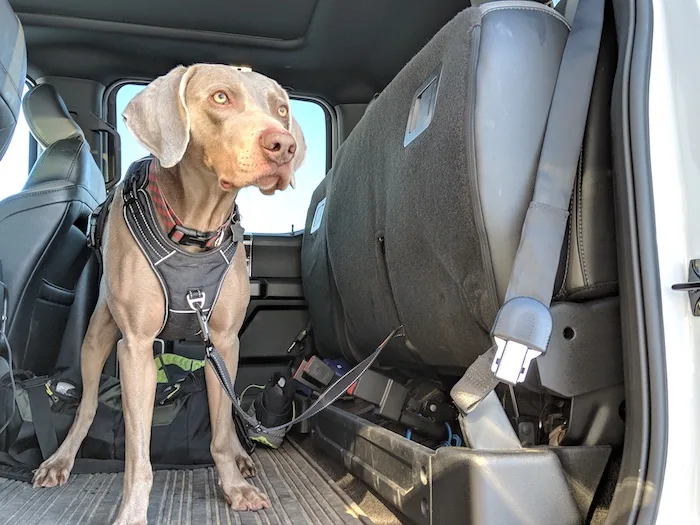
Benefits of a dog safety belt:
1. No more distracted driving. A dog seat belt keeps your dog to one area instead of jumping from seat to seat or bumping into you!
2. Keeps the dog secure. Use the safety belt with a harness to keep your dog safe and secure.
3. Keeps most dogs calmer. A seat belt prevents them from hopping around in the vehicle from window to window and seat to seat. It actually helps a lot of dogs remain calmer (Remy!)
4. Prevents damage to your vehicle. Your dog won’t be able to scratch the center console. Plus, it also keeps the dog hair and dirt to a smaller area.
5. Prevents dog from bolting out. Your dog won’t be able to jump out and bolt until you are ready to unclip him.
6. Required by law. Some states have proposed laws for requiring dogs to be restrained when riding in vehicles. Here is a recent article on current proposed laws for restraining dogs in cars.
Another option is to keep your dog in a crate while traveling, but that can be cumbersome, for larger dogs. If you prefer a crate, a fold-up wire crate is most convenient.
Visiting rest areas with your dog:
If you’re traveling alone with your dog in hot weather, it helps to pack your own food in a cooler. That way you’re not waiting in line for “fast” food while your dog is locked in a hot car. I pack sandwiches for myself when I travel with my dog in the summer.
Dogs in the back of pickups
We don’t like to see dogs in the open area of pickups for obvious safety reasons. In some areas, such as Minnesota, it is illegal for a dog to ride in the back of a pickup without a suitable crate or other restraint.
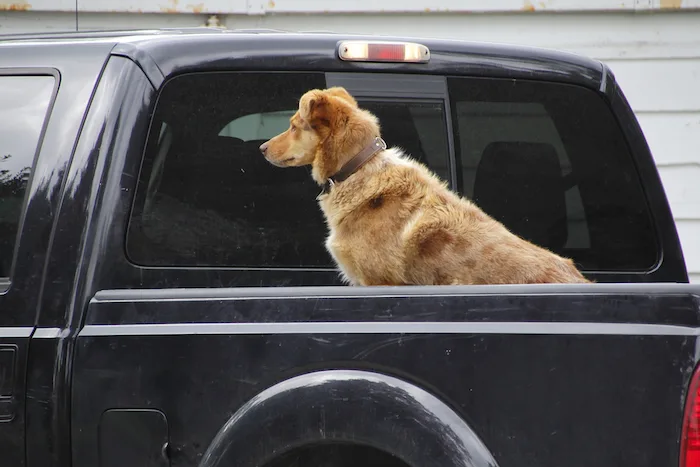
While we understand some dogs are used to riding in the truck on rural backroads, we would hate for the dog to jump out of the truck (maybe he wants to chase another dog) or be thrown from the truck.
*To get this post emailed to you as a pdf, click here. Read it later at your convenience.
One time I was driving behind a pickup truck in a small farming town. While we were stopped at a railroad crossing, the dog got excited and decided to jump out of the truck! The dog’s owner had to leave his truck and catch his dog! Thankfully the dog was fine.
If your dog must ride in the back of the truck bed, we recommend you use a large, plastic crate that is securely tied down. The best brand for this by far is Gunner Kennels. Their crates are designed for hunting dogs. The company designed it to keep dogs safe even in a crash, and it is designed to keep dogs comfortable in all weather conditions.
For longer rides, it can get too hot for the dog in the open area of the pickup or too cold, so it’s better for the dog to ride in the cab.
This leads us to cold and hot weather safety tips for dogs …
Cold Weather Safety Tips for Dogs
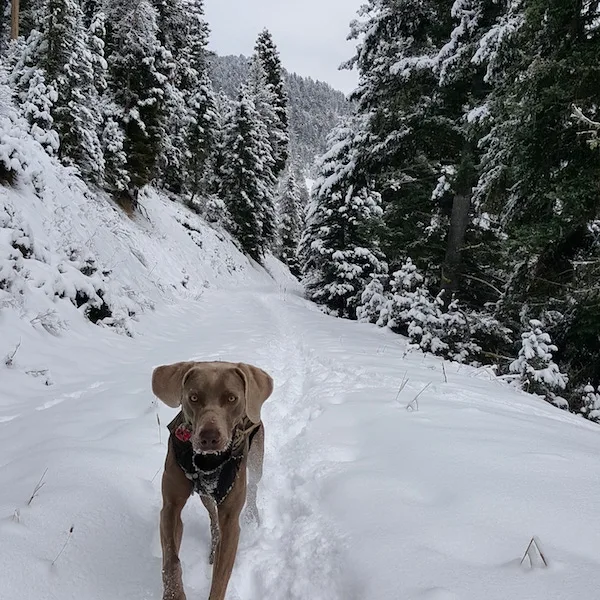
Cold weather is a challenge all dog owners are faced with, and while a brisk walk in the snow or cold can be a lot of fun, we suggest keeping the following safety tips in mind when the temperatures drop:
- Use common sense and don’t exercise your dog outside when it’s too cold for yourself.
- Play indoor games such as hide & seek instead to keep your dog entertained.
- Offer him chew toys/treats or feed his meals in a dog puzzle to challenge him mentally.
- Always offer fresh water to eliminate the risk of dehydration, both indoors and outdoors.
- Keep your dog at a safe distance from wood burning fireplaces and candles to avoid the risk of his fur catching on fire.
- Provide a warm sleeping place for your dog. We recommend the faux fur beds from Treat A Dog.

- Try using doggie boots when walking your dog on icy or cold surfaces to protect his paw pads. Brands we like are Ruffwear and Muttluks. See our Muttluks review here.
- Try using a doggie jacket or coat if your dog doesn’t have an insulating undercoat and/or starts shivering quickly when outside in the cold. We like Ruffwear’s Cloud Chaser jackets featuring reflective trimming.
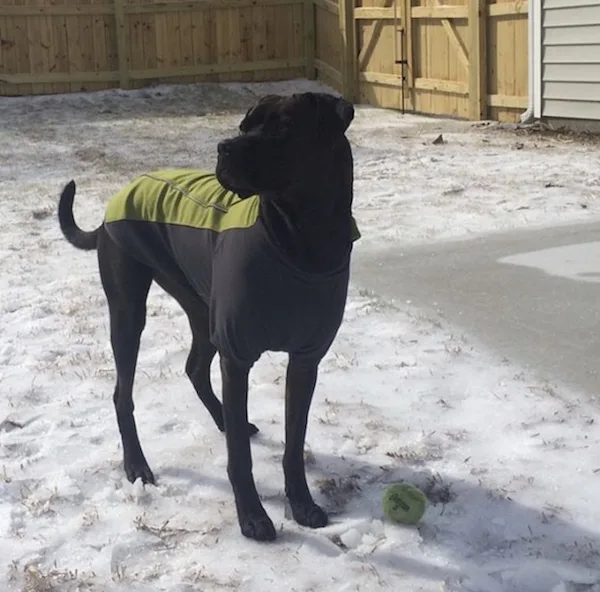
- Use ointments for cracked paw pads to keep them soft and in good shape during the cold weather. Coconut oil is a good alternative.
- Wash your dog’s paws if you’ve walked him without doggie boots in an area where ice melt products have been used. They can be toxic when ingested.
- Use pet-friendly ice melt products on your own property such as Green Gobbler Pet Safe Ice Melt, Natural Rapport Pet and Kid Friendly Ice Melt, or Safe Paw Non-Toxic Ice Melter.
- Don’t leave your dog outside unsupervised when the temperatures drop and snow starts to fall to avoid the risk of hypothermia.
- Be prepared to cut cold weather walks and hikes shorter than planned if conditions are worse than you thought
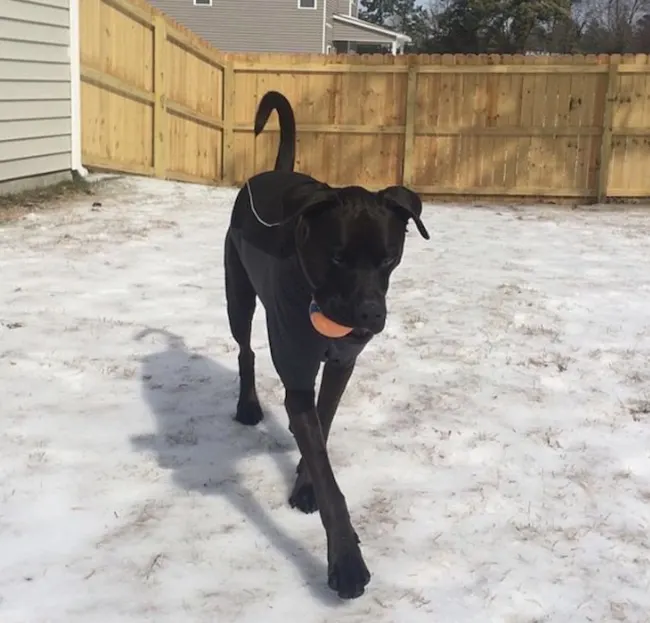
What to do when your dog suffers from hypothermia
Symptoms of hypothermia in dogs include:
- Shivering and shaking
- Lethargy
- Pale or blue gums
- Slow heart rate and breathing
- Dilated pupils
- Body temperature below 100°F (a dog’s normal temperature is between 101-102.5°F)
If you notice these symptoms in your dog, bring him inside and wrap him in warm towels or blankets. Offer warm liquids such as bone broth, either homemade or store bought, but don’t force any down your dog’s throat.
Monitor his body temperature using a pet thermometer from your doggie first aid kit. Bring him to your vet if his condition stagnates or worsens.
See our post: 6 ways to exercise your dog when you’re stuck indoors
Hot Weather Safety Tips for Dogs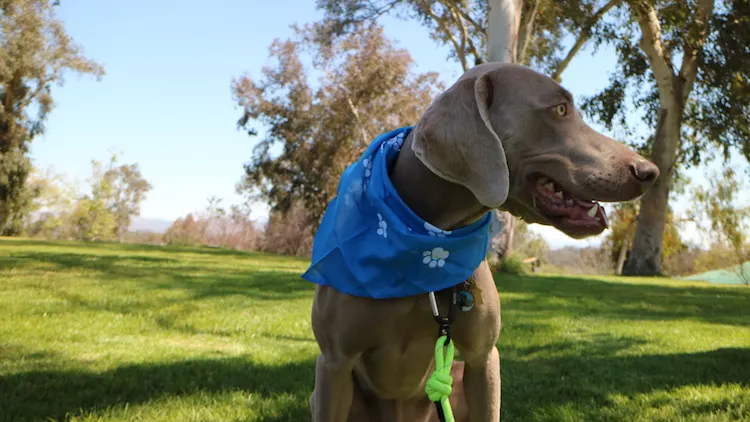
We are big believers in exercising our four legged friends & ourselves year-round, but the dog days of summer (pun intended!) can be a real drag.
That’s because a dog’s only way of cooling himself off is by panting and sweating through his paw pads, but unfortunately neither method is very effective.
This applies to all dog breeds, and is particularly true for short nosed breeds with shortened nasal passages such as Boxers, Pugs, Shih-Tzus, Bulldogs, and many others. These dogs are also known as “brachycephalic.”
How to keep your dog cool in the summer:
- Don’t leave your dog outside in the yard unsupervised and please don’t force him to stay inside a dog house. They offer no protection from the sun.
- Don’t leave your dog inside the garage either because it heats up quickly. Even insulated garages are generally too warm for dogs when it’s hot outside.
- Don’t leave your dog alone in a hot car. Cracked windows offer no relief from the heat.
- Walk on grass rather than hot pavement & sand, both of which can burn a dog’s paw pads. A good way of testing the heat of a surface is by using the hand test – if it’s too hot for the back of your hand, it’s too hot for your dog’s paw pads.
- Try doggie boots to avoid contact with hot surfaces. Brands we like are Ruffwear and Muttluks.
- Limit longer walks/exercise sessions to early morning and/or late evening hours when temperatures drop a little.
- Keep your dog in the shade as much as possible when you take him outdoors during the day.
- Limit games like fetch since some nutty sporting dogs (and certain Boxer mixes…Buzz!) will not quit on their own!
- Bring water along on walks and always offer fresh water inside your home.
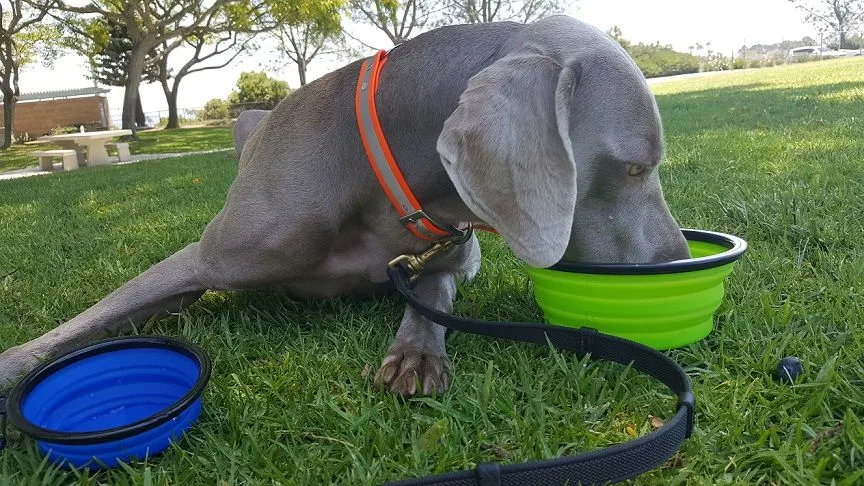
- Offer refreshing treats such as homemade raw goat milk treats and watermelon (without the seeds).
- Play water games in the yard by using a kiddie pool and/or a sprinkler.
- Consider investing in cooling accessories such as cooling vests to wear and cooling mats to lie on. The latter ones helped me out tremendously when my Jeep’s AC decided to stop working in the middle of an extended summer road trip with Missy. I found the next pet retail store and bought two!
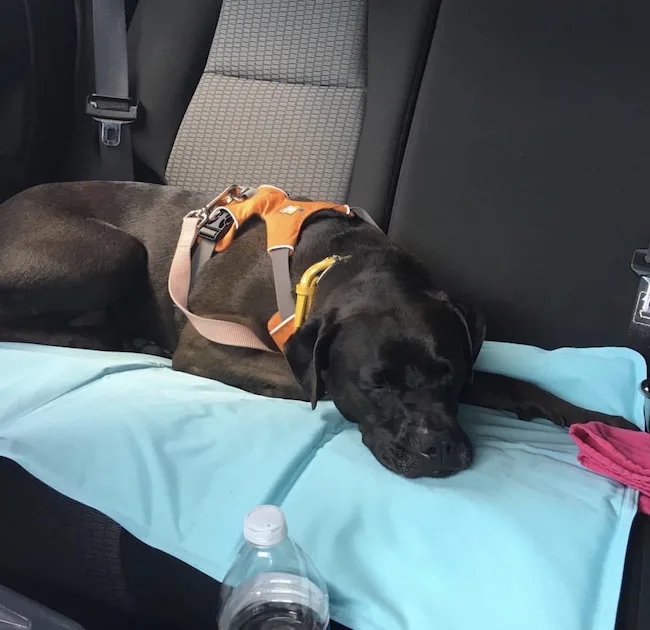
What to do when your dog overheats
Symptoms of an overheated dog include:
- Heavy panting
- Excessive thirst
- Bright or dark red gums and tongue
- Body temperature above 103°F (a dog’s normal temperature is between 101-102.5°F)
- Stumbling around or collapsing
If you notice any of those signs, remove your dog from any sun exposure and bring him to a cool place, ideally indoors. If possible, have him lie on a cool surface such as tile or hardwood, and wrap cool towels around his belly and paws. Offer fresh, cool water, but don’t force any water down your dog’s throat.
Monitor his body temperature using a thermometer from your doggie first aid kit.
If his condition doesn’t improve, take him to your vet to be on the safe side and to avoid heat stroke which is usually fatal.
Camping and hiking safety tips for dogs
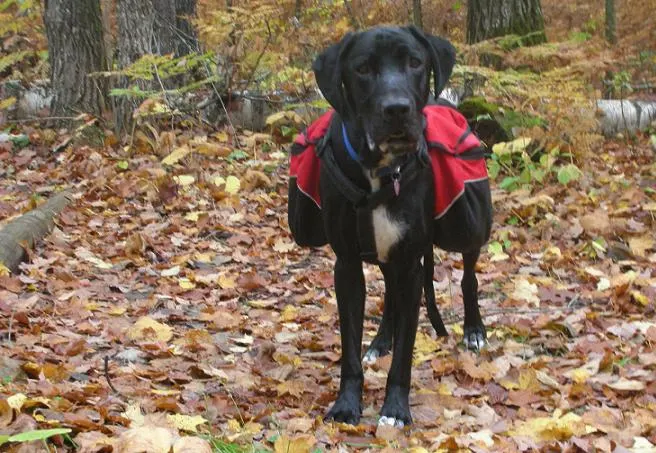
As mentioned before, we love spending quality time outdoors with our dogs! The following safety tips are geared towards camping and hiking adventures:
- Always bring fresh water along on hikes. If your dog wears his own backpack, he can carry his own water (and yours too!) in the backpack pockets. More weight in the pack helps tire out an active, high-energy dog too!
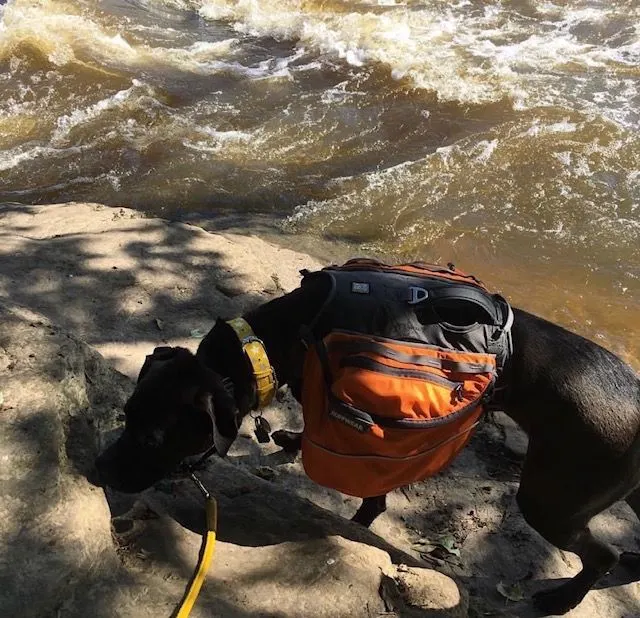
- Consider using doggie boots for ultimate paw protection if you’ll be hiking on rocky terrain. Brands we like are Ruffwear and Muttluks.
- Bring a doggie first aid kit along on camping trips and hikes, especially on longer ones. See my tips on how to make a first aid kit for your dog
- Bring an extra collar and leash along should the regular collar and/or leash break or get lost.
- Carry a loud whistle or bell and a means of self defense on you, such as a clip-on pepper spray, bear spray or a hiking stick.
- Depending on where you live, treat your dog with flea and tick preventatives before any hiking and camping adventures, ideally the natural kind as opposed to chemical options. Also consider heartworm treatment, but be aware of the potential cons of this type of medication. Your (holistic) vet will be happy to educate you about different options.
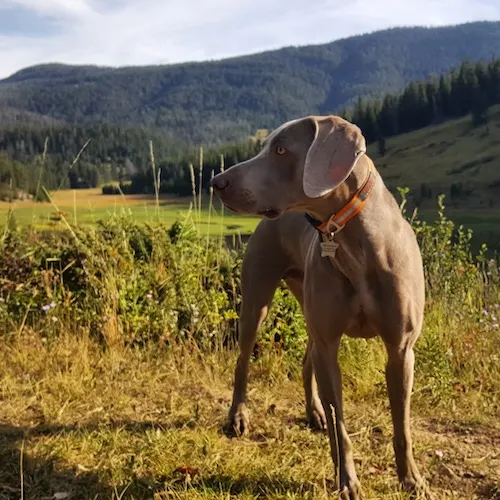
- Keep your dog at a safe distance from camp fires to avoid burns.
- Make sure that your dog wears legible tags featuring his name and your phone number, and that they’re firmly attached to his collar or hiking gear.
- Bring a copy of your dog’s rabies certificate in case he gets injured and requires medical treatment from a veterinarian.
- Consider dressing your dog in a bright color such as blaze orange during hunting season.
- Consider a GPS collar if you’ll be doing any off-leash hiking or hunting with your dog. Lindsay just started using a Garmin collar for Remy that can track up to 9 miles using GPS (no cell reception required).
- Keep your dog on a leash to limit the chances of unpleasant encounters with wildlife, especially venomous snakes, bears, coyotes, and wild cats.
- Bring an extra long leash 30 feet or longer if you’re considering letting your dog swim in a lake or river. It’s a good way of keeping him safe and being able to reel him back in if necessary.
- Before you head out, know what type of plants are in the area such as poison ivy or poison oak. While most dogs don’t react to these plants (their fur protects them), they can spread the oils to your skin and cause you to have an allergic reaction. (No fun!) More info on these plants here.
- Be aware of the potential danger of venomous water snakes in certain areas of the US, especially in the Southeastern coastal states. You may want to reconsider letting your dog swim in those areas as a preventative measure of avoiding snake bites.
- Also be aware of rattlesnakes. They are found throughout the US, have diamond-shaped heads, are venomous and can give themselves away by hissing and making a rattling sound with the rattles at the end of their tail. Pay close attention to your surroundings and stay on marked trails.
What to do if your dog gets bitten by a snake:
If your dog gets bitten by a snake, check to see how many bite marks the snake left on your dog and try to identify the (venomous?) snake if he’s still within sight. If you’re able, get a quick picture of the snake to show the vet. This is VERY important! If the vet doesn’t know what type of snake bite him, they won’t be able to give your dog the proper anti-venom.
If your dog has bite marks on his legs, apply a compression using gauze wrap or a piece of clothing above the bite mark to slow the spread of the venom. Keep your dog as still as possible for the same reason, and take him to the vet for treatment.
There is a rattlesnake vaccine available, however it is somewhat controversial and vets generally don’t recommend it for the average dog.
The vaccine does not necessarily give your dog immunity but can potentially buy you more time to get to the vet, especially if you will be hiking, camping or hunting in remote areas.
*To get this post emailed to you as a pdf, click here. Read it later at your convenience.
Additional Resources:
My dog was bitten by a rattlesnake
Rattlesnake bite prevention in dogs
Info on rattlesnake vaccine for dogs
A few other tips for hiking with your dog:
If you’ll be camping or hiking in remote areas without cell reception, consider putting a friend’s phone number on your dog’s tag (someone who typically doesn’t hike with you). That way, if someone finds your dog, at least he would be able to call a number that works.
If hiking is a regular activity for you and your dog, you might even make a second tag used for hiking.
For hikes in areas with large animals like bears or mountain lions, put a bear bell on your dog’s collar so you’re less likely to accidentally startle these animals. It’s usually better if they hear you coming!
Quick off-leash safety tip:
We highly recommend you work with your dog on the commands “come” and “stay.”
While other cues like heel and sit and down are important, getting your dog to stop/stay or to come when called are the most important and could potentially save her life. We also recommend you work on “drop” and “leave it.”[/box]
Common Poisons to Dogs in the Home and Yard

There are many common items both inside and outside of our homes that are poisonous to dogs such as certain foods, household items, and yard hazards. Always keep them out of your dog’s reach, either behind shut doors, in drawers, cabinets, high up on shelves or elevated surfaces.
It’s also a good idea to make sure that your dog can’t get into the trash and to let your kids and house guests know never to share any dangerous food items with your dog, regardless of how pleading the pup’s eyes might look!
Dangerous food items for dogs:
- Chocolate (the darker, the more toxic)
- Baking dough
- Grapes
- Onions
- Nuts
- Cooked bones
- Sugarless gum that contains Xylitol
- Alcohol
- Coffee
Dangerous household items for dogs:
- Human medications and pet medications
- Cleaners
- Car fluids
- Interior and exterior paints and primers
- Pest control products like insecticides and rodenticides
- Plants such as Lilies, Aloe plants, Chrysanthemums, Poinsettias, Dieffenbachias, Tulips, Sago palms

Poisons in the yard for dogs:
- Ice melt chemicals
- Pool chemicals
- Fertilizers
- Plants such as Mums, Azaleas, Daffodils, Oleanders, Amaryllis, Mistletoe
- Mushrooms such as Death Caps, Panther Caps, Galerinas, Fly Agarics, Angels of Death, False Parasols, False Morels, Conocybes
It’s a good idea to monitor your yard for mushrooms popping up especially after periods of heavy rain, and to make sure that your dog doesn’t have (unsupervised) access to garden areas featuring dangerous plants.
If your dog ate a suspicious mushroom and you end up having to take him to the vet, try to bring a mushroom sample along. Wrap it in paper rather than bagging it in a plastic bag to keep it fresh.
Teaching your dog a solid “leave it” or “drop it” command can also go a long way in avoiding a potentially fatal scenario.
What to do when your dog exhibits signs of poisoning
Symptoms of poisoning in dogs include:
- Vomiting
- Diarrhea
- Drooling
- Excessive thirst
- Lack of appetite
- Lethargy
- Weakness
- Collapse
- Increased heart rate
- Fever
- Disorientation
- Seizures
If you notice any of these signs and suspect that your dog was poisoned, call and/or take your dog to the (closest) vet and try to quickly assess what your dog ingested. It’ll help the vet determine the gravity of the poisoning as well as the necessary treatment.
Hydrogen peroxide can be used to induce vomiting in dogs (however it is toxic to cats!).
Sometimes it is a good idea to induce vomiting in your dog, and sometimes it is not. When in doubt, ask your dog’s vet.
According to Dr. Jennifer Pittman, a critical care specialist at BluePearl-Georgia Veterinary Specialists in Atlanta, you can give your dog approximately 1 teaspoon per 5 pounds of body weight.
For more info: How to make a dog throw up
[box type=”download”]Additional Resources:
You can call the Pet Poison Helpline at 800-213-6680, or Animal Poison Control at 888 426-4435 for advice.
Or visit https://www.petpoisonhelpline.com/
Consider saving those numbers to your phone and in your dog’s first aid kit so you don’t have to look them up when you need them![/box]
First Aid for Dogs
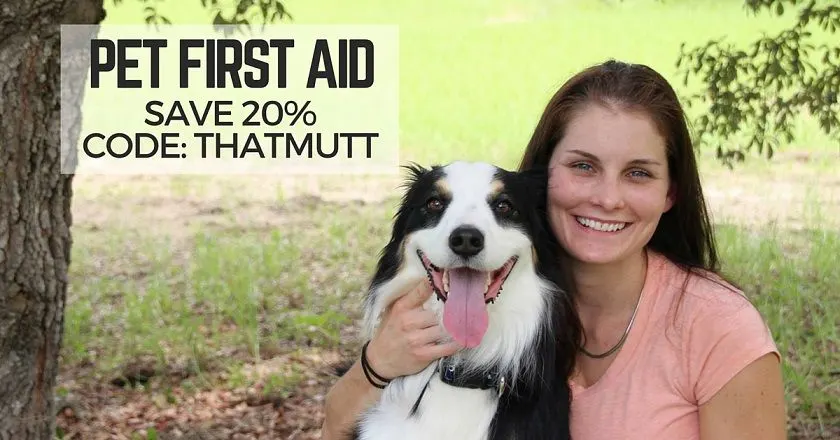
In an emergency it could take up to 20 minutes or more to drive your dog to a vet. Worse, what if the vet is closed or you’re camping and you have no access?
That is why we highly recommend you take a pet first aid & CPR course. This is a no-brainer if you’re a pet sitter, but it also makes sense for ALL pet owners.
In addition to being certified in pet first aid, we recommend all dog owners have a pet first aid kit on hand.
What to put in a first aid kit for your dog
You could buy a first aid kit for your dog or make your own. For more info: How to make a first aid kit for your dog
Ideas include:
- Phone numbers to your dog’s vet and local emergency animal hospital
- Gauze wrap
- Sterile bandages
- Medical tape
- Antibiotic cream such as Neosporin
- Hydrogen peroxide for wound cleaning
- Cotton balls or swabs
- Nylon slip lead (in case you don’t have a leash/collar)
- Muzzle (see our post: how to get your dog used to a muzzle)
- Pet thermometer
- Your dog’s medications
- Scissors
How to Safely Introduce Two Dogs
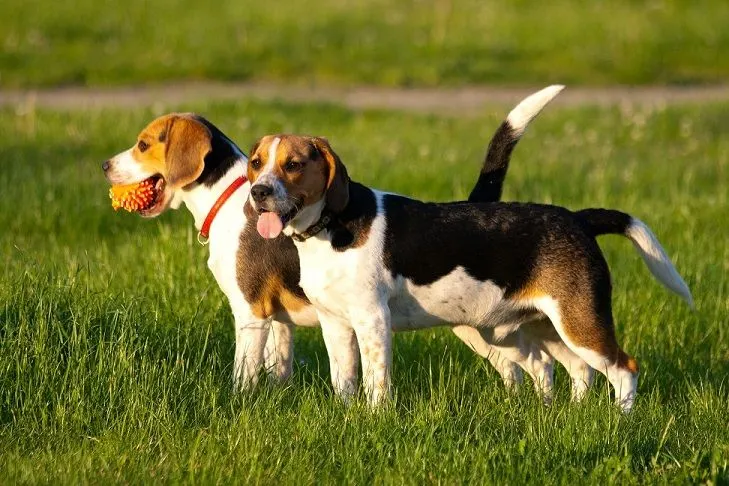
Most dogs are able to greet other dogs without issues, but sometimes people can unintentionally set their good dogs up for failure.
We believe the best way to introduce two unfamiliar dogs is on a long walk in a neutral area such as a park or neighborhood street. Instead of approaching each other head on where the dogs are face to face, one handler should walk one dog a few yards ahead of the other.
Another option is to walk parallel from one another such as on opposite side of the street. Walking this way helps the dogs get used to each other’s scent and energy without the pressure to interact.
Depending on the dogs, if all goes well, you could let them greet one another after a few minutes. Others might need more time.
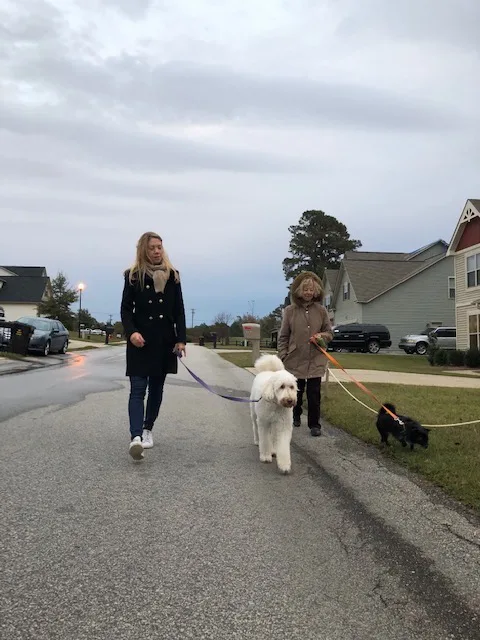
Mistakes to avoid when introducing two unfamiliar dogs:
- Avoid tension in the leashes – keep leashes loose
- Avoid direct, head-on eye contact
- Avoid baby talk because this adds excitement
- Limit excitement (both people and dogs)
- Don’t hand out treats or food to avoid potential food aggression
- Don’t offer toys to avoid potential toy possessiveness
- Avoid introductions on one of the dog’s home turf to avoid territorial behavior
- Don’t pick up and hold a small dog if you’re introducing dogs of different sizes to avoid possessive behavior of the human handler. Pretend the small dog is the size of a grown Mastiff – you wouldn’t/couldn’t pick him up either!
- Sometimes it’s unavoidable but we do not recommend jerking the leash as a correction or to get a dog’s attention because sometimes this can trigger a reaction from one or both dogs. It’s better to get the dog’s attention by whistling or clicking your tongue, like “Hey Bailey, look here!”
When introducing two unfamiliar dogs we recommend:
- Introduce unfamiliar dogs on neutral territory, ideally on a long walk.
- Let them sniff each other’s butts if they seem relaxed and comfortable with each other. It’s the polite canine way of getting to know another dog.
- Read the dogs’ body language. Dogs who are comfortable around each other will appear relaxed and curious, those who are uncomfortable will be stiff. Other signs of stress can be a tucked tail, snarling, growling, lunging, and raised hackles, although the latter can also simply be a sign of excitement. That’s why it’s important to interpret a dog’s reaction as a whole and to familiarize yourself with the meaning of dog body language before introducing two (or more) unfamiliar dogs.
- Separate and monitor unfamiliar dogs at feeding time until you get a sense of how they act around food in another dog’s company. You could feed in different rooms, inside crates, or put up baby gates.
- Take things slowly! No need to rush interactions between strange dogs.
- If the dogs do have a minor scuffle, don’t overreact. It’s often just “talk” and the dogs will likely move on almost immediately.
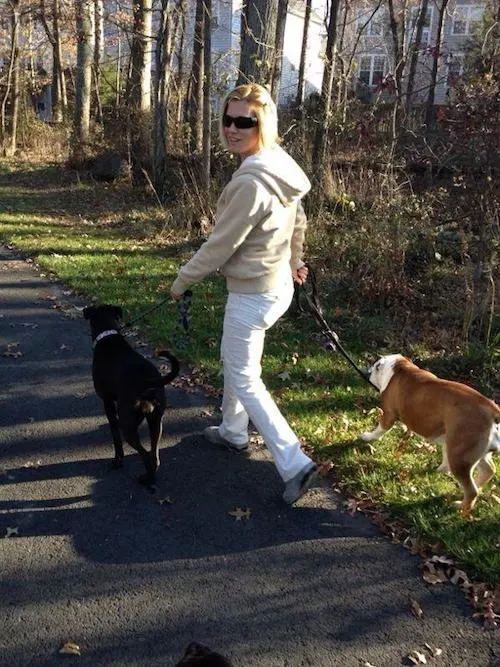
What to do when two (or more) unfamiliar dogs don’t get along
If your dog doesn’t seem to get along with an unfamiliar dog (or more) right away, it’s best not to get frustrated over it. Dogs pick up on our emotions and tend to mirror them, so don’t add to your dog’s stress level by stressing yourself out. Maybe you just need to take things slowly and try to re-introduce them again a few days later.
If you’ve tried a few times and they truly don’t get along, that’s ok too. Remember, just like us humans don’t like every single human we meet, there are going to be dogs your dog won’t be interested in being around.
Additional Resources:
How to slowly introduce two dogs
What to do if your own dogs fight
Dog Safety Products – Top Picks!
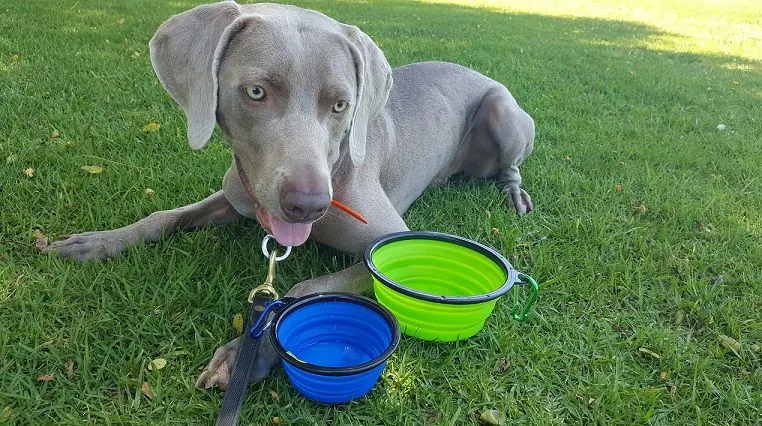
The following are some safety products you may want to have for your dog. Most of these were mentioned earlier, but we wanted to make a list.
Dog first aid products:
- Dog first aid kit: Buy one or make your own
- Pet thermometer
- The book The First Aid Companion for Dogs & Cats, by Amy Shojai
- Hydrogen peroxide on hand to induce vomiting in dogs
- Tick remover such as Tick Twister
- Soft muzzle to keep injured dog from biting
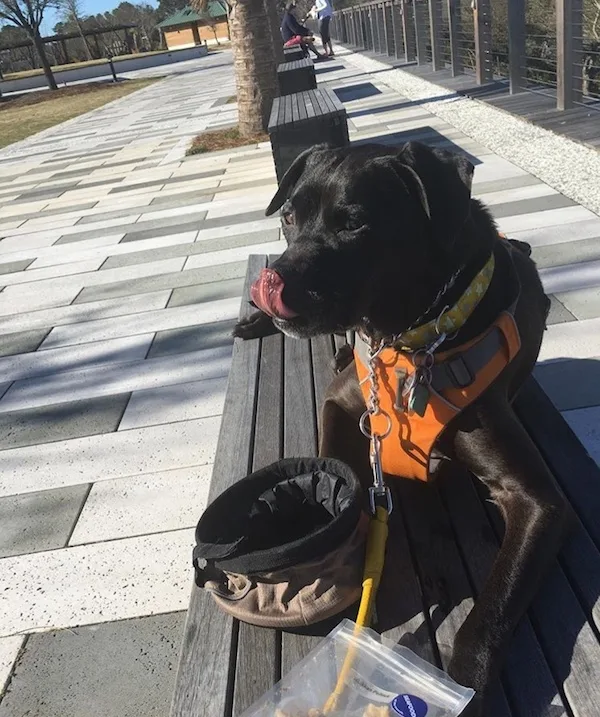
Dog Travel & Adventure:
- Dog seat belt
- Bear bell for hiking in remote areas
- Dog GPS collar
- Dog booties from Ruffwear or Muttluks
- Collapsible dog water bottles/bowls
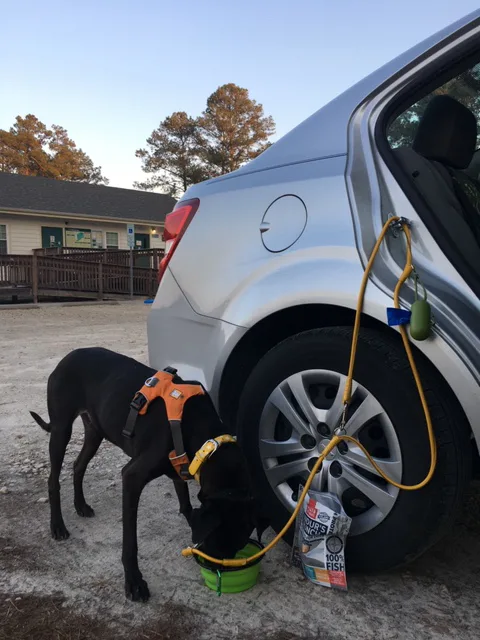
- Blaze orange vest during hunting season
- Short “traffic handle dog leash” to keep excitable dogs out of trouble in high traffic environments like at the vet’s or on busy city streets
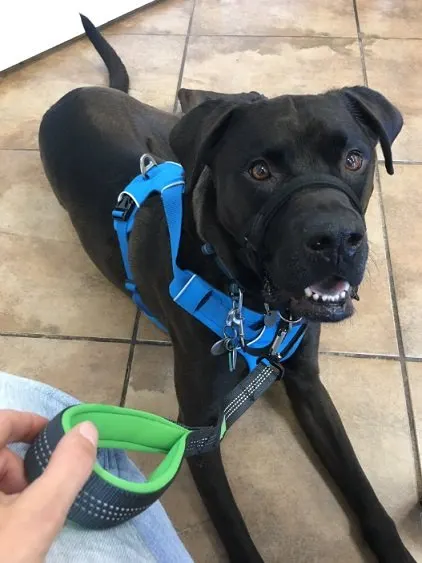
What safety tips for dogs would the rest of you add to our list?
We know we can’t cover everything in this article, but we wanted to give you as much information as we could. In the comments, let us know what other safety tips you recommend and if there are any products you believe could benefit others.
Please share this post if it will help someone you know!
*To get this post emailed to you as a pdf, click here. Read it again at your convenience.
Barbara Rivers writes regularly for That Mutt. She is a blogger, raw feeder and dog walker and maintains the blog K9s Over Coffee. Lindsay Stordahl also contributed to this post.

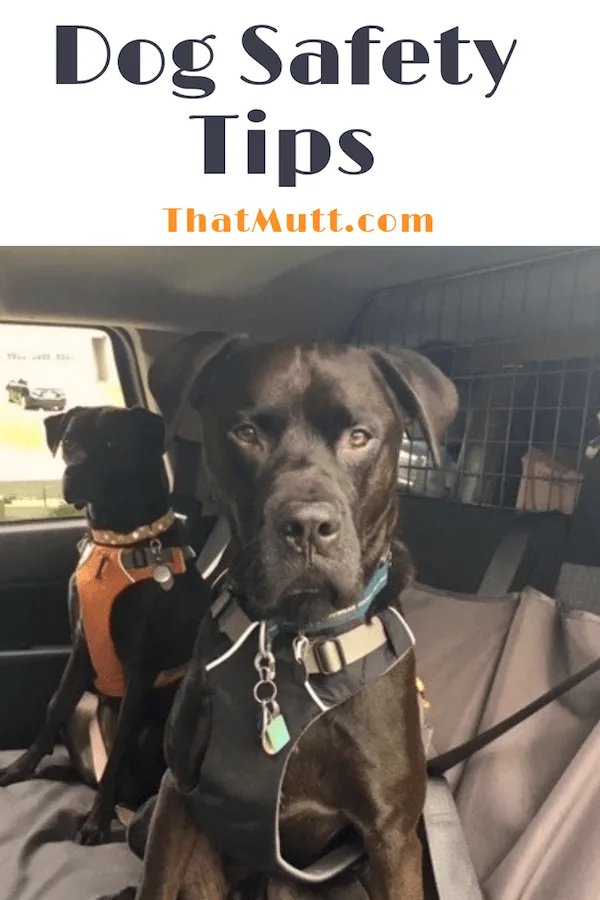
Michaela Hemsley
Thursday 15th of August 2019
Thanks for pointing out that when traveling with your dog you should make sure your dog’s ID tag and microchip are up to date. I am thinking about taking my dog with me on my next vacation because I don't want him to have to sit home alone for that long. I think it would be smart to make sure all his tags are up to date and also look up where the nearest animal clinic to where we are staying is just in case something happens while we're there.
Rebecca Sanchez
Monday 14th of January 2019
I just love this post, it's jam packed with helpful information! I particularly liked reading about the dog-friendly ice melt items - we need that at our cabin when it gets icy - great recommendations.
Ruby and Kristin
Friday 11th of January 2019
Wow, this post is packed with info and I'm going to share and save. I love the faux fur bed! Thanks for posting the list of dog friendly ice melt products. I've actually been looking for recommendations.
Thanks also for the reminders about introducing unfamiliar. I admit, I have been guilty of picking up our dog (she's about 16 pounds) when another dog reacts negatively towards her. I need to stop doing this!
Barbara Rivers
Sunday 13th of January 2019
It's a natural reaction to want to pick a small dog up! That's why I enjoy thinking of small dogs as extra large - no way I could pick a giant dog up :)
KL
Saturday 5th of January 2019
We had a Nosework trial last summer in nearly 100-degree heat. To add to that, you often crate in your car between searches AND you aren’t typically allowed to run your engine. With that kind of heat on a sunny, humid day, keeping my girl cool and comfortable was a big concern.
I bought a Ryobi fan and brought a spare lithium battery. We used both batteries that day, running the fan in the car, so I’d highly recommend having one or even two spares in case one goes out earlier than expected.
I also brought a cooler and a bath towel. I stopped on my way to the trial and bought ice to fill the cooler. I doused the towel with water and stuck it in the ice-filled cooler. Between searches, I tucked the cold wet towel around her midsection, taking care to have it under her arms, and I aimed the fan at the towel. When we were searching, I stored the towel in the cooler with the ice.
Also a key weapon in our arsenal were two large Aluminet blankets and clips to attach them to my car. They are surprisingly effective at keeping the sun from heating your car to the temperature of Mercury, and they allow pretty decent ventilation if you have your windows open.
Obviously this wasn’t ideal, but it worked for the day. I had a happy, comfortable, and titled dog by the end of it!
Lindsay Stordahl
Sunday 6th of January 2019
Thank you, those are all really great ideas I would not have thought of!